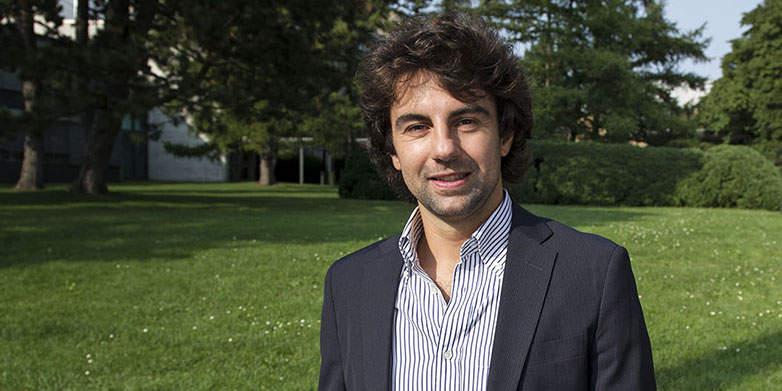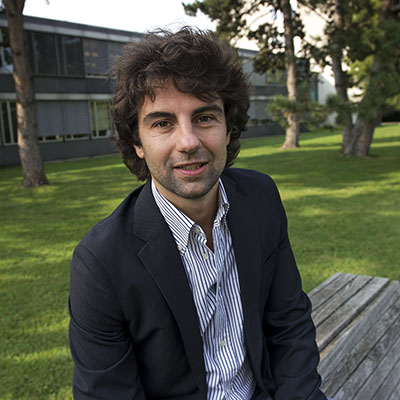Making our cities greener
Branco Weiss fellow Gabriele Manoli wants to enrich urban research with quantitative models and establish a new science dedicated to creating green cities. He has found the ideal location for this: Zurich.

I meet up with Gabriele Manoli for an espresso in the café of the Swiss National Museum in Zurich. Naturally the coffee does not taste quite as fine as in his home town of Venice, but the 32-year-old environmental engineer has no complaints. On the contrary, he is fascinated by Zurich – by the urban planning practised here and the almost seamless development of the city on the Limmat.
Although he grew up no more than four hours’ drive from the border, he only visited Switzerland for the first time 18 months ago, when he started a postdoc position at ETH Zurich. He has now been at the Hönggerberg campus since June 2016, working as a researcher in the Chair of Hydrology and Water Resources Management. “Zurich is paradise to me, second only to my own home town,” Manoli says. As often as possible, he catches the train to visit his parents and friends in Venice. After working in the USA for two years, he’s glad to be back in Europe and closer to home.
Creative chaos and cool reasoning
Manoli’s scientific career started at the University of Padua, “where Galileo Galilei was once Professor of Mathematics,” he adds proudly. Initially he couldn’t decide whether to study medicine or environmental engineering. “In the end, I was quite taken by the idea that my role as an environmental engineer would be like a doctor looking after the planet.”
He began his Masters at the University of Padua and completed it at the Technical University of Denmark. “It was here that I first became really excited about research,” Manoli recalls. The well-developed research infrastructure and the disciplined work ethic were new to him. “In Italy, we are very good at improvising, and you learn to be creative,” he explains. “But it wasn’t till I moved to Denmark that I learnt how to organise myself professionally, plan projects, work to deadlines and apply for research funding.” Nowadays he is convinced that successful research combines both approaches: creative chaos and cool reasoning.
In the long run, Denmark was a little too cold for his liking –both emotionally and regarding the weather. So he moved back to Padua to complete his doctoral research. One of his supervisors there was specialised in mathematical modelling. “That was right up my street,” Manoli remembers. “It quickly became clear to me that I wanted to work with mathematical models from then on.”
For his doctoral thesis, he modelled the water cycleat the catchment scale. These calculations allow the effects of weather extremes and flooding to be assessed more accurately. “Most models only take into account soil processes, but not the vegetation that provides ground cover,” Manoli explains. This prompted him to start integrating plant physiology – trees, shrubs and grasses – into his models. To this he added factors such as water uptake or evaporation via plants. Although the models became more complex as a result, they were also more accurate.
Mediating between disciplines
Ecohydrology is still a relatively new line of research that examines the interactions between the water cycle and the functioning of ecosystems. Engineers and hydrologists work together with biologists, ecologists and agricultural scientists to studythe water balance of natural ecosystems, such as forests, deserts and croplands. Increasingly, climate scientists are brought on board as well so that models are expanded to include atmospheric processes that shape the Earth’s water budget.
“I find collaboration with researchers from different disciplines particularly rewarding,” Manoli says. He claims to be less of a specialist and more of a mediator between different disciplines. “I am convinced that both specialists and intermediaries are essential for achieving research excellence.”
Research beyond the boundaries of one discipline
It is precisely this type of young researcher that the foundation “Society in Science” aims to support with the Branco Weiss award. Every year, this ETH foundation provides funding to scientists engaged in research that goes beyond the boundaries of their own discipline. To win the award, they must be prepared to move out of their comfort zone and engage with the social impacts of their research. Manoli first came up with the idea for his research project while in the USA: during his doctoral studies, he applied for a position with the “Senseable City Lab” at the Massachusetts Institute of Technology (MIT). “I had this vision of a new data-based science for the green cities of the future,” Manoli recalls. But instead of joining MIT in Boston, he took up his first post-doc position at Duke University in North Carolina, where he applied ecohydrological models to study the impact on water resources of pine plantations in the USA.
But the idea of a data-based science for green cities stayed with him. When he started his work in Zurich, he found fertile ground for his ideas at the Department of Hydrology and Water Resources Management. On top of that, some of his academic colleagues were also involved in research with the Futures Cities Lab in Singapore, where the focus is on planning sustainable cities. He could therefore continue to develop his ideas in numerous discussions with colleagues.
“Engineers and architects are usually focused on a specific project – a bridge, railway line or landmark building,” Manoli explains. “In the field of urban studies, researchers in turn see the city as an organism but often tend to lack the quantitative understanding about the physical processes going on within the city.”
Manoli pictures a type of urban research that bridges these gaps. Although mathematical models are already used in urban studies, they are mainly targeted at economic and social issues and tend to overlook environmental planning aspects. He gives a practical example of the benefits of such research: “I’d like to be able to quantify which plants are most effective in reducing the heat island effect occurring in large conurbations. Or: does it make more sense to plant trees on top of high-rise buildings, as pioneered in the “Bosco Verticale” in Milan, or to create new parks?”
In the right place
The vision of a data-based science for green cities certainly impressed the Branco Weiss jury, who awarded Manoli an annual external pagegrantcall_made of CHF 100,000 over the next five years. It is up to him how he organises his research. Furthermore, the grant is not tied to a specific university. “I could have gone anywhere,” Manoli says. “But as far as my research plans are concerned, I’m already in just the right place.”
The appeal of ETH Zurich also lies in its global reputation in urban studies and environmental engineering, along with access to colleagues working for the Futures Cities Lab in Singapore. He plans to visit them for the first time over the coming months. During his visit, he will be looking to establish multidisciplinary research collaborations for developing new ideas, such as how to build more sustainable cities using data and mathematical models.
Idealism is an important facet of Manoli’s research: “Humanity is only a microscopic part of the universe,” he says. “If the human race is to survive, there has to be an immediate and radical change in the way we treat our environment.” He has therefore set himself the goal of sharing the results of his research with society, through museums, schools and public events. He discovered just how important such outreach work can be while working in the USA. “A model alone is not enough to change the world,” he realises. “But if we can share our research with the public, we can at least encourage a shift in the right direction.”

